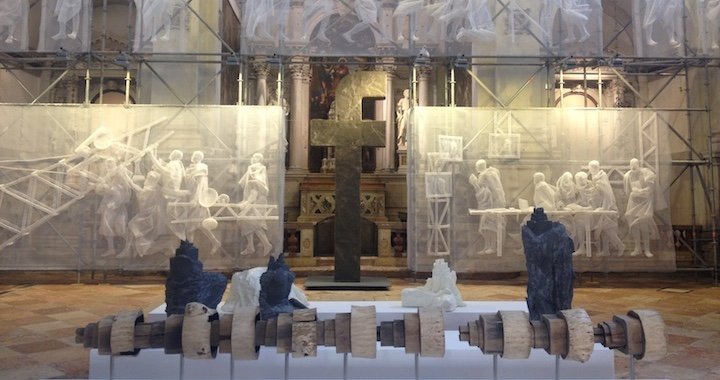
Rubber. Plaster. Don’t take it down till November
Interview with Krasnodar-based art group Recycle
Alexandra Artamonova
27/08/2015
Photos provided by Recycle, shot by Christina Romano
Recycle Art Group consists of two young artists, Andrey Blokhin and Georgy Kuznetsov, who graduated from the Academy of Industrial Arts in Krasnodar and are winners of the most prestigious (in Russia) Kandinsky Prize in 2010. They are known for their monumental sculptures from plaster, polyurethane rubber, plastic and generally anything recyclable. At any rate, one of their works, a giant letter F, which is both a cross and symbolic representation of “Facebook”, was seen by a lot of people.
During the parallel program of the 56th Venice Biennale, Recycle presented their new project, a completely site-specific installation called “Conversion”. The old church of St. Anthony, founded in the VII century, is now (until November of this year) the place where the “new apostles” are converted to a “new faith”, the faith of virtual reality, the heavenly Cloud storage of all the information, there are answers to all the questions, and the eternal life after death is promised on one of the social networks. The “Facebook” shown as a type of cross is at the center of the altar.
Arterritory spoke with the art group Recycle, or, more precisely, with one of its members Andrey Blokhin about new works, the spiritual and the virtual world of modern rituals and how and for whom “Google” has replaced God.
Andrey, hello! Are we going to talk altogether or will it just be you answering questions?
Well Egor is running around covered in plaster at the moment so I think I will tell you everything, and he might join in once in a while.
And he is covered in plaster because he broke something or...
No, he is running around in plaster because we are making new sculptures (laughs).
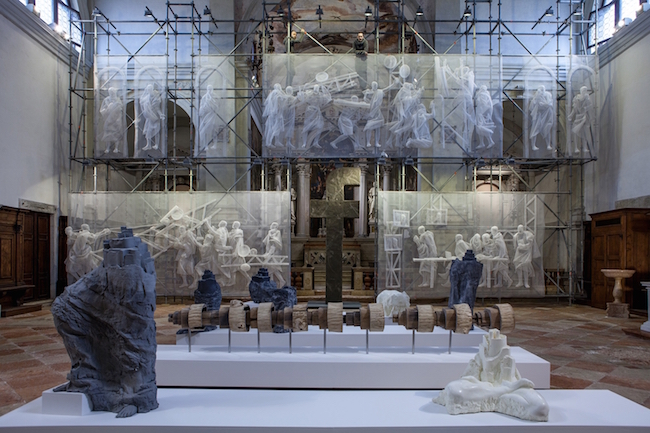
Well, then let us begin. I think it’s logical to start our interview by asking you about your latest work “Conversion”, which was exhibited in the parallel program of the 56th Venice Biennale. In my opinion, the title of the piece is incredibly successful as it is multifaceted and it resonates well with the name of your group. Here we are dealing with a kind of metamorphosis: roughly speaking, trash suddenly becomes the material that fine art is made from, the medieval church becomes something modern, a type of informational church, and so on.
You’re completely right. The word “conversion” has two meanings. The first is technical, it implies the transformation of one system into another, for example changing one format into another, or any other types of conversions. The other meaning has to do with religion, the conversion from one faith into another, or converting to a specific faith, as people say. Therefore it was imperative to show this work at the St Anthony church.
It took us two years to prepare the “Conversion” project. We thought about how to install these objects with an optimum fit into the church’s space, we discussed and looked for parallels between the virtual and the spiritual world. Both of these worlds exist in some way, although we can’t touch them or somehow feel them physically, and often these worlds intersect. For example, the bell tower of the church in which we have done this installation there are digital antenna for radio transmission. It just so happens that historically crosses were always placed on the highest point, and now next to these crosses we often find cellular antennas in order to carry out the distribution of communications... So we fantasized on the subject of new rituals, new religions, new worlds and how everything affects one another. And that is how the finished work came about.
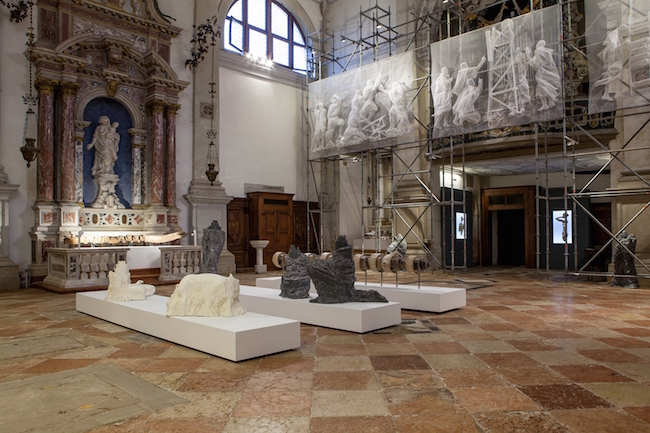
But overall the appeal to Christian symbolism and iconography is not new for you. Before this work you made “Gates”, “Scrolls”, and you had stained-glass windows on which you put Kenny (from the “South Park” cartoon) as a great martyr... Would you say that for you “Conversion” is a concentrated statement which stitched together all the different thoughts about virtual and spiritual worlds?
Yes, in a way it is an accumulation of researching the topic which we started to explore a few years back and which we are still working on. In 2012 we had an exhibition at the Multimedia Art Museum called “Paradise Network”, which featured “Facebook” (the piece that is now in the center of the installation at the altar in Venice), “Gates”, “Scrolls” and many others. This theme will also exist in our new works in some way, but in a completely different context. We are moving toward slightly different stylistic and visual maneuvers but at its core it still mixes well with what we have already done.
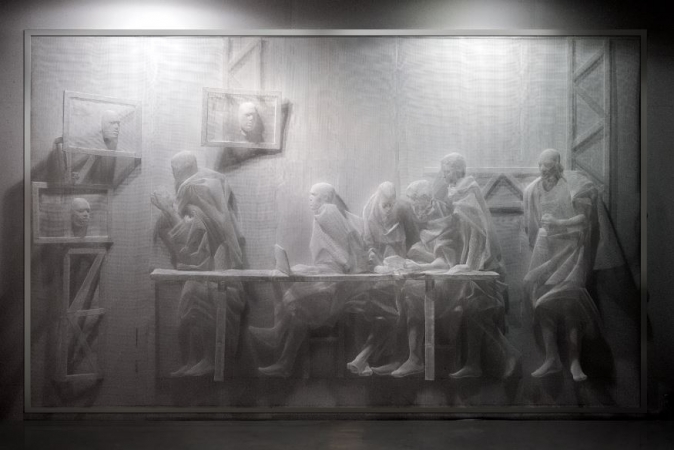
Recycle Group. Conference-call. Plastic net. 300x500 cm. 2014. Press photo
I remember that exhibition at MMAM really well. I think even at the time your “Facebook” piece could visually be read as a Latin cross which one of its planks simply leaning to the side. But in Venice “Facebook”, situated in the center of the installation and therefore the center of the altar, is seen even clearer and its appearance promises the viewers eternal life in one of the social networks, if not the complete kingdom of heaven.
That’s exactly it. But back in 2012 we were trying to show an example of a kind of virtual paradise with our “Facebook”, because people can put the best snippets of their life on their profiles, the ones that they want to share and create this type of heavenly nest with them. And these profiles can live forever according to the capabilities of social media.
Tell me about the process of choosing the location for your installation, especially because you needed a church to install it in.
Yes, we had that idea initially, and we started looking for a place, and in the end we got lucky with St Anthony’s church.
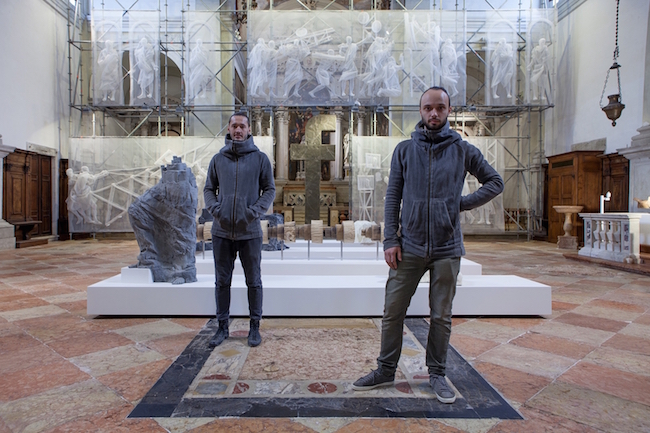
Since this is a functioning church, did you have to get special permissions from the priests and other church workers to place your project there?
I wouldn’t say that it is a fully functioning church, it only has one room in which they hold church rituals. As for agreements and permissions, we didn’t encounter any problems. We met up with the Catholic cardinal, we showed him our plan for the exposition, all our drawings, we talked about where we would place “Facebook”, where the other elements would go. The Catholic church is somewhat loyal to such things, their criteria is less strict in terms of what is allowed and what is not. Plus Venice has many churches that rent out space for different events, for example during the last Biennale the same church hosted Ai Weiwei’s exhibition. We had many diverse people with different religious backgrounds come to our preview, we even saw a rabbi. The next day we had a second opening, a calmer one, and it mostly included our friends and partners from the US. All in all, everything turned out to be very peaceful.
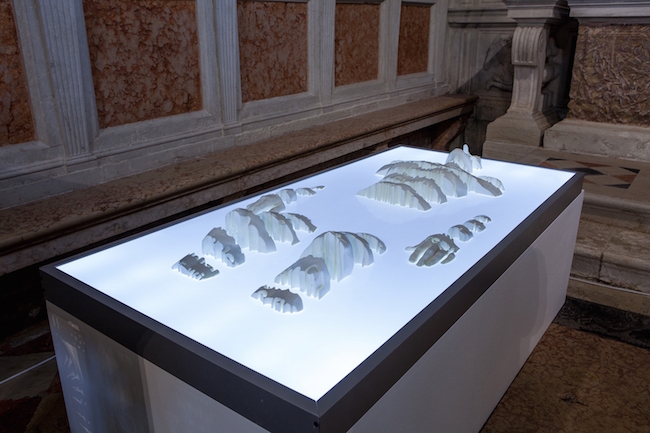
Due to the cultural context today, do you think you could show “Conversion” now in Russia, the way it was planned with the “Facebook” sign, the altar and so on, but in a Russian Orthodox church?
I seriously doubt that we would be allowed to do something like that. We haven’t thought about it, haven’t talked to anyone about it, and we don’t really have this goal anyway. What is important for us is the space, not the rituals that are held there.
One more thing that is very interesting for me. What is “Conversion” to you as an artist? Is this the creation of a kind of dystopian world, in which gadgets and virtual reality have replaced everything?
Mostly these are ironic motives, we don’t have a concrete religious preference. More precisely, for us it is not fundamental to work with Christian themes. “Conversion” is an ironic look at what can happen in the world with a certain scenario of events. We have created a fantasy world which we project onto the realities of life. After all, if you think about it, using all these gadgets and even virtual reality takes up a lot of time for people. Previously, a person could come to the church to ask all his questions, and now, most likely, to find an answer to a question he would use “Google”.
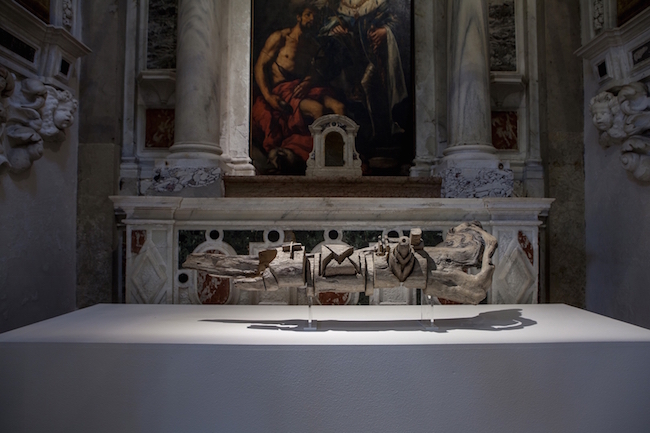
And this is considering the fact that in “Google” the question might be answered by a priest. There is a really cool and funny story: one Pskov priest has a blog online and anyone can ask him about absolutely anything. For example, can someone hex a cat over the internet and so on.
And the Pope has a Twitter account, so everything is in order with that too.
If we think about the language of the virtual world, then we realize that it is also a little “heavenly”, all the “icons”, the magical “cloud”...
Yes, that is exactly right. But just think about the fact that there is a cloud of cosmic proportions that can store absolutely any information, from which nothing disappears, nothing gets deleted and so on. And there are profiles of people who had died, so the person is no longer here but their profile is left on social media. So you get a fun game with this virtual other world which we don’t know, because everything is beautifully illuminated on our screen, but behind those icons there is a much bigger meaning than we could ever imagine. And there is a moment of sacralization, which we are showing in this exhibition.
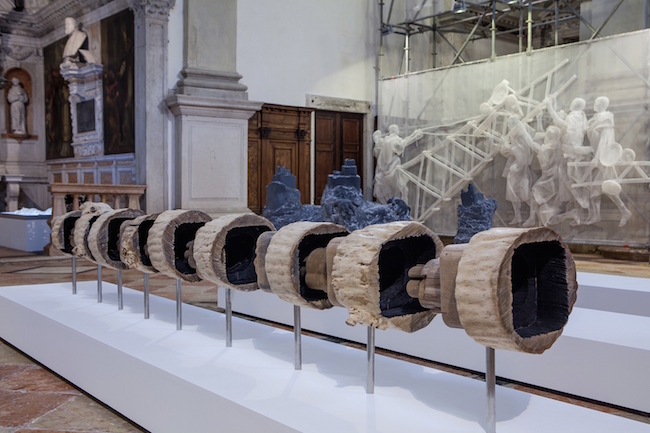
That in itself is a very ambitious project and seems expensive in terms of production, no?
Yes, it’s quite pricey. We got help from our partners, La Fabrique Barbot et Fournier, a French company organized by Oleg Cherkunov to support Russian art abroad. Also the gallery “Triumph”, which was largely responsible for the running of all the processes, and the Museum of Modern Art, which functioned as kind of museum on the road. We made the objects in our studio in Krasnodar and from there transported them to Venice.
What about the technological process?
Well, for us it is always very long and complicated, we needed to find the right textures, we made silicone casts from them, we used new technologies which we had previously never worked with, like the water jet cutter and so on. We used new (for us) materials, for example wood. So all in all we had some technological experiments, but that happens in every project that we begin working on.
Well, that is understandable. And what are your plans for the future?
We are going to Iceland next week, where we will shoot our new project. Then there will be at Artinternational Istanbul, in October we have a solo exhibition in London, in February we have one in Paris. At the small solo exhibition in London we will show our new project, produced using a technology new for us, because before we had never worked in photography, but in Iceland we are shooting a photo project, which we will exhibit in an installation. Truth be told, a correctly selected technological key is also an instrument.